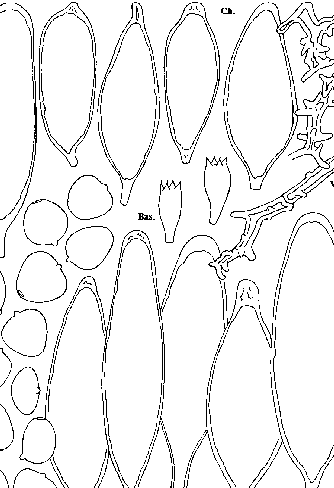Macroscopic features |
Pileus 2-6 x 2-4 mm when still closed, up to 15 mm when expanded, ellipsoid, ovoid or conical, greyish, beige (Mu. 7.5 YR 7/2; K. & W. 6B2). Veil greyish with pinkish tinge when young, soon greyish, breaking up in small, felty patches. Lamellae free, first white, then grey-brown to dark grey or blackish. Stipe up to 50 x 1-1.5 mm, white, greyish white, somewhat floccose at clavate base. |
Microscopic features |
Spores [60,2,1] 6.7-8.7 x 5.5-7.7 x 4.5-5.2 µm, heart-shaped, rounded triangular with rounded apex, distinctly lentiform, medium to dark red-brown and central or slightly eccentric, c. 1.5 µm wide germ pore; Q = 0.95-1.45, av. Q = 1.00-1.20; av. L = 7.0-7.9, av. B = 6.5-7.2, av. W= 4.8-5.0 µm. Basidia 16-24 x 9-11 µm, 4-spored, surrounded by 4-7 pseudoparaphyses. Pleurocystidia 80-120 x 24-32 µm, utriform, oblong, (sub)cylindrical or conical with yellowish contents forming a layer inside the walls. Cheilocystidia 60-100 x 22-28 µm, similar to pleurocystidia. Elements of veil thick-walled, multiple-branched and diverticulate, 2-6 µm wide; walls up to 2.5 µm thick, almost colourless. Clamp-connections present. |
Habitat & distribution |
Solitary or a few together, on dead grasses on clay. Very rare, only known from one collection. |
Remarks |
Among the spores in spec. Uljé 1262 we found some ellipsoid and ovoid ones which resemble the spores of C. friesii. Also the structure of the veil agrees very well with that of C. friesii with slightly coloured and very thick-walled elements. While it is possible that this collection represents a deviating form of C. friesii, the spores are in greatest part distinctly triangular or heart-shaped, and for that reason a separate description is given. |

[Copyright © by Uljé]